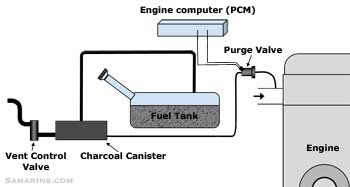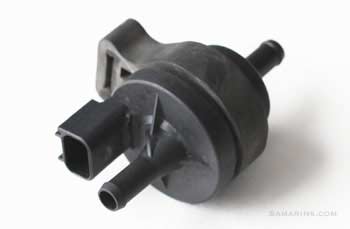Purge valve: how it works, symptoms, problems, testing
Purge valve: how it works, symptoms, problems, testing
The EVAP system prevents fuel vapors in the fuel tank from escaping into the atmosphere. The EVAP system traps fuel vapors from the fuel tank and temporarily stores them in the charcoal canister, see the diagram.
 EVAP system diagram
EVAP system diagramIn modern cars, the purge valve is an electrically-operated solenoid, that is controlled by the engine computer. When the engine is off, the purge valve is closed. When the engine is running and fully warmed up, the engine computer pulses the purge valve open allowing some amount of fuel vapors to be purged from the charcoal canister and burned in the engine. When the purge valve operates, it might produce a rhythmic clicking noise under the hood.
The purge flow is monitored by a number of sensors. If the purge flow is less or more than is expected under certain conditions, the computer illuminates the "Check Engine" light.
Purge valve problems are common in many cars. In some Hyundai models (Elantra, Santa Fe, Tucson, Tiburon), a stuck-open purge valve is fairly common to cause the "Check Engine" light with the code P0441.
Purge valve problems
The most common problem with the purge valve is when it sticks or does not close fully. This may cause the "Check Engine" light to come on. In some cars, a stuck-open purge valve can cause difficulty starting right after refueling at a gas station: for the first few seconds the engine may run rough and stumble.Purge valve problems are common in many cars. In some Hyundai models (Elantra, Santa Fe, Tucson, Tiburon), a stuck-open purge valve is fairly common to cause the "Check Engine" light with the code P0441.
Similar problems are fairly common in many European cars, including Audi and Volkswagen. In some Ford and Mazda vehicles, a faulty purge valve can cause the code P0446 and other EVAP codes.
A leaking purge valve is not uncommon in some GM vehicles. For some cars, the purge valve warranty coverage has been extended. Google: GM purge valve special coverage.
The purge valve is not very expensive ($35-$65 for the part) and is fairly easy to replace. In most cars, it's attached to the engine or the intake manifold. For example, see this photo of a purge valve in the Jeep Grand Cherokee.
How the purge valve (solenoid) is tested
You can find the proper procedure to test the purge valve in the vehicle's service manual. The procedure is different depending on the car make and model. In most cars, the purge valve is normally closed, meaning it should be closed with no voltage and open when the voltage is applied.

For example, for this vehicle, the service manual recommends applying battery voltage to the purge valve terminals and see if it produces an audible click. We just use a 9-volt battery to illustrate. This purge valve does produce an audible click.This purge valve does produce an audible click.
Testing a purge valveThe next step, as per the service manual for this car is to test if the purge valve closes properly and does not leak. We connect a hand-held vacuum pump and apply vacuum to the purge valve.
Testing a purge valveAlmost immediately, the vacuum drops. This purge v
alve doesn't seal properly and must be replaced. This car had a "Check Engine" light on the dash. We had it scanned and got the code P0446 - Evaporative Emission Control System Vent Control Circuit Malfunction.
alve doesn't seal properly and must be replaced. This car had a "Check Engine" light on the dash. We had it scanned and got the code P0446 - Evaporative Emission Control System Vent Control Circuit Malfunction.
We tested the EVAP system and found that it had a slow leak. Now we have found the culprit!
Testing a purge valveTo illustrate the difference, we tested the purge valve from a different car. It holds the vacuum very well, even after one minute the vacuum hasn't dropped.
Almost immediately, the vacuum drops. This purge valve doesn't seal properly and must be replaced. This car had a "Check Engine" light on the dash. We had it scanned and got the code P0446 - Evaporative Emission Control System Vent Control Circuit Malfunction. We tested the EVAP system and found that it had a slow leak. Now we have found the culprit!
Testing a purge valveTo illustrate the difference, we tested the purge valve from a different car. It holds the vacuum very well, even after one minute the vacuum hasn't dropped.
Testing a purge valveNow we connect the battery voltage. The purge valve clicks and the vacuum immediately drops. This purge valve is good.
Beside a purge valve, the EVAP-related Check engine light codes are often caused by a faulty vent valve or a gas cap.

.jpg)


Comments
Post a Comment